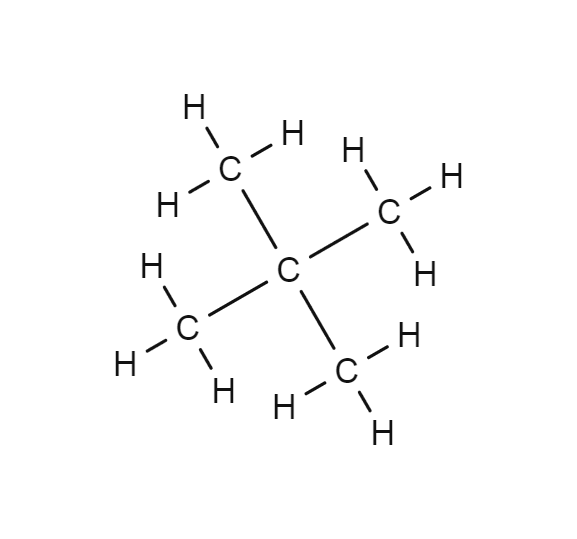
Neopentane
- C5H12
- CAS Number 463-82-1
- UN2044 (gas)
Click & drag to move the 3D molecule
Liquid / Gas Volumes
Calculate the volume or mass of a quantity of gas or liquid
Liquid Phase
At boiling point at 1.013 bar
Gas Phase
In standard conditions (1.013 bar, 15°C)
Physical Properties
Molecule phase diagram showing the transition phases between solid, liquid and gas as a function of temperature and pressure
-
- Molar mass 72.149 g/mol
- Content in dry air /
-
Critical Point
- Temperature 160.65 °C
- Pressure 31.96 bar
- Density 235.01 kg/m³
-
Triple Point
- Temperature -16.55 °C
- Pressure 3.54E-1 bar
Pressure 1.013 bar
| Latent heat of fusion (at melting point) | 43.6 kJ/kg |
| Melting point | - 16.55 °C |
Pressure 1.013 bar
| Boiling point | 9.5 °C |
| Latent heat of vaporization (at boiling point) | 315.692 kJ/kg |
| Liquid density (at boiling point) | 601.172 kg/m3 |
| Gas density (at boiling point) | 3.255 kg/m3 |
| Vapor pressure | 7.117E-1 bar |
| Compressibility factor Z | 9.5839E-1 |
| Cp/Cv ratio γ | 1.0919 |
| Gas density | 3.1839 kg/m3 |
| Gas/(liquid at boiling point) equivalent | 188.87 vol/vol |
| Heat capacity Cp | 1.6695 kJ/(kg.K) |
| Heat capacity Cv | 1.529 kJ/(kg.K) |
| Specific volume | 3.141E-1 m3/kg |
| Thermal conductivity | 15.525 mW/(m.K) |
| Vapor pressure | 1.231 bar |
| Viscosity | 7.0232E-5 Po |
| Compressibility factor Z | 9.6308E-1 |
| Cp/Cv ratio γ | 1.0869 |
| Gas density | 3.0621 kg/m3 |
| Gas/(liquid at boiling point) equivalent | 196.38 vol/vol |
| Heat capacity Cp | 1.7147 kJ/(kg.K) |
| Heat capacity Cv | 1.5777 kJ/(kg.K) |
| Specific volume | 3.266E-1 m3/kg |
| Thermal conductivity | 16.528 mW/(m.K) |
| Vapor pressure | 1.715 bar |
| Viscosity | 7.2589E-5 Po |
Applications
Examples of uses of this molecule in Industry and Healthcare
Safety & Compatibility
GHS02
Flammable
GHS09
Hazardous to the environment
Autoignition Temperature, Flammability Limits & Flash Point
Europe (according to EN1839 for Limits and EN 14522 for autoignition temperature)
| Autoignition temperature (Chemsafe) | 450 °C |
| Lower flammability limit (IEC 80079-20-1) | 1.3 vol% |
| Upper flammability limit (IEC 80079-20-1) | 7.5 vol% |
US (according to ASTM E681 for Limits and ASTM E659 for autoignition temperature)
| Autoignition temperature (NFPA 325) | 450 °C |
| Lower flammability limit (NFPA 325) | 1.4 vol% |
| Upper flammability limit (NFPA 325) | 7.5 vol% |
Threshold of toxicity
| ILV-8h EU (at Patm and 293.15 K) | 3000 mg/m3 or 1000 ppm |
| VLEP 8h France (at Patm and 293.15 K) | 3000 mg/m3 or 1000 ppm |
Metals
| Aluminium | No data |
| Brass | No data |
| Monel | No data |
| Copper | No data |
| Ferritic Steel | No data |
| Stainless steel | No data |
| Zinc | No data |
| Titanium | No data |
Plastics
| Polytetrafluoroethylene | Satisfactory |
| Polychlorotrifluoroethylene | Satisfactory |
| Polyvinylidene fluoride | Satisfactory |
| Polyvinyl chloride | Satisfactory |
| Ethylene tetrafluoroethylene | No data |
| Polycarbonate | No data |
| Polyamide | Satisfactory |
| Polypropylene |
significant swelling
Not recommended
|
Elastomers
| Butyl (isobutene- isoprene) rubber |
significant swelling
Not recommended
|
| Nitrile rubber | Satisfactory |
| Chloroprene | Satisfactory |
| Chlorofluorocarbons | No data |
| Silicone |
significant swelling
Not recommended
|
| Perfluoroelastomers | Satisfactory |
| Fluoroelastomers | Satisfactory |
| Neoprene | No data |
| Polyurethane | No data |
| Ethylene-Propylene |
significant swelling
Not recommended
|
Lubricants
| Hydrocarbon based lubricant | No data |
| Fluorocarbon based lubricant | No data |
Materials compatibility
Learn More
More information
Neopentane, also called 2,2-dimethylpropane, is a double-branched-chain alkane with five carbon atoms. Neopentane is an extremely flammable gas at room temperature and pressure which can condense into a highly volatile liquid on a cold day, in an ice bath, or when compressed to a higher pressure.